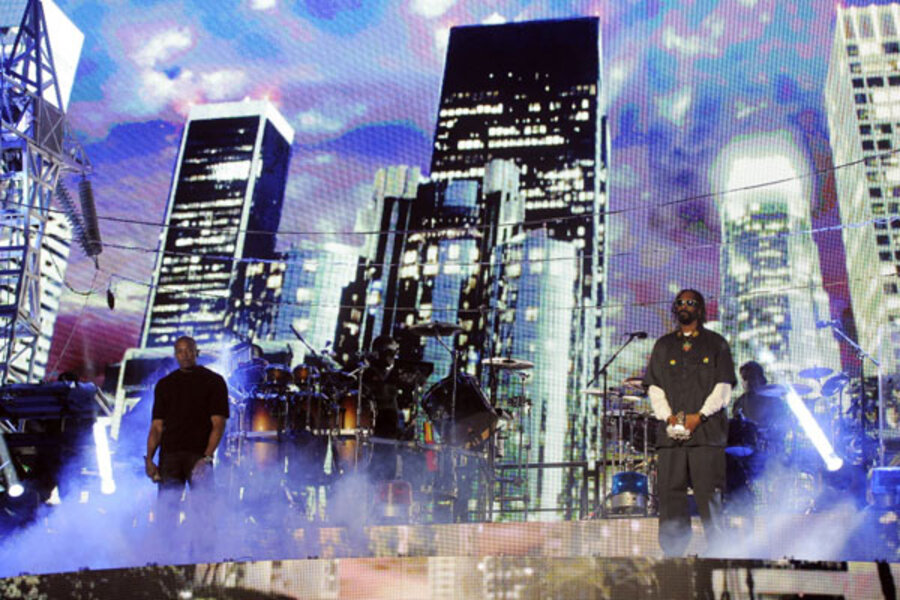Tupac Shakur hologram: how new technology is invading the real world
Loading...
| Los Angeles
When slain rapper Tupac Shakur turned up alongside Dr. Dre and Snoop Dog at the Coachella Music Festival this weekend, he stunned fans with his rendition of “Hail Mary,” and “2 of Amerikaz Most Wanted.”
Many wondered how this rapper, gunned down in Las Vegas in 1996, could be brought to such convincing life in what is not merely a projection of a previous performance, but a new creation.
The act, which will be reprised this upcoming weekend, is the fruit of 19th century mirror tricks – much like the type used in séances – combined with state-of the art, 21st century motion capture and hologram projection technology. It was powered by Hollywood special effects giant, Digital Domain, which aged Brad Pitt for “The Curious Case of Benjamin Button.”
This moment and the resulting publicity frenzy is the shot across the bow for this technology moving forward, says Renaud Skalli, head of artist and label relations for My Love Affair, an international agency dedicated to pairing artists and brands. “This is just the beginning of many more things like this to come,” he says, adding, “This just begins to give an idea of what is doable.”
From London to Las Vegas, the inanimate and the no-longer-living are joining the completely digital creations in real-world “appearances.” Grover, the furry character from Sesame Street, popped out on the dais at this year’s Consumer Electronics Show to help the Qualcom team deliver a keynote address.
Across the pond, the East London firm responsible for resurrecting Frank Sinatra to sing for Simon Cowell’s 50th birthday party also brought a legendary, deceased ad-man, Paul Ardin, to life in Cannes, where his company Saatchi & Saatchi held its annual New Directors’ Showcase. He walked onstage, squinted at the lights, then said, “Well, I’m glad to see Saatchi’s New Directors’ Showcase is still alive and well. Unlike me.”
After a short speech, he evaporated in a poof of smoke, leaving his microphone to drop to the ground, according to London’s Daily Telegraph.
Airports in both London and Paris have begun experimenting with digital boarding agents that materialize out of thin air to guide passengers to their gates, both amusing and confusing children and adults alike.
This intrusion into the real world is beginning to happen all over, says Jason Yim, CEO of the marketing firm, Trigger, adding that “you are going to begin seeing things like characters jumping off cereal boxes and crawling around the breakfast table and creatures coming down from movie posters.” Right now, he says, “every poster, every bus shelter or kiosk could initiate this kind of digital experience.”
For now, says Mr. Yim, the human eye can still discern what is fake and what is real. But within five years, he suggests, “that line will begin to blur.”
Beyond that, he points out, with so many modes of communication available now, the possibilities for being fooled by a digital creation are expanding exponentially. “How do you know who or what is behind an instant message, an email or an SMS?” he asks.
The reality of a character, he says, is determined by so many levels of communication, adding, “that line is going to blur more and more.”
Look no further than the world of online dating for evidence that this blurring is well underway, says online relationship adviser, April Masini. She says emotionally vulnerable Internet users already take chances with digital connections.
“Multiple, daily texts, e-mails, phone calls, and Skype sessions make people feel like the relationship is real,” she says via e-mail, adding that while they may be real, “it’s just not real serious. Hologram infusion in these relationships are going to change the nature of relationships.”
Ms. Masini says it may sound crazy. “Who would allow themselves to invest in a relationship with a hologram,” she says, but adds, based on her experience as a relationship advice expert, “there will be plenty of men and women for whom a hologram is better than a broken heart.”





